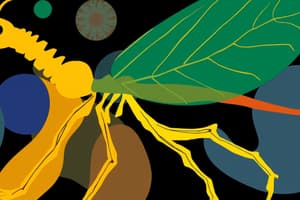Podcast
Questions and Answers
What does the mnemonic 'Kings Play Chess On Fine-Grained Sand' help to remember?
What does the mnemonic 'Kings Play Chess On Fine-Grained Sand' help to remember?
- The characteristics of fungi
- The kingdoms of life
- The seven levels of classification (correct)
- The scientific names of organisms
What is the scientific name for the European white water lily?
What is the scientific name for the European white water lily?
Nymphaea alba
What genus does the European white water lily belong to?
What genus does the European white water lily belong to?
Nymphaea
When scientists classify organisms, what do they arrange them into?
When scientists classify organisms, what do they arrange them into?
By what characteristics did Linnaeus attempt to classify all known organisms?
By what characteristics did Linnaeus attempt to classify all known organisms?
What is the scientific name for the common house cat?
What is the scientific name for the common house cat?
What does the order Carnivora contain?
What does the order Carnivora contain?
What is the largest, most general group in the classifications used by biologists?
What is the largest, most general group in the classifications used by biologists?
What is the species name in the scientific name Felis domesticus?
What is the species name in the scientific name Felis domesticus?
What science is Linnaeus known for founding?
What science is Linnaeus known for founding?
The seven levels of classification, from general to specific, are __________.
The seven levels of classification, from general to specific, are __________.
How do fungi obtain nutrients?
How do fungi obtain nutrients?
What are Plantae, Animalia, and Protista?
What are Plantae, Animalia, and Protista?
What kingdom do molds and mushrooms belong to?
What kingdom do molds and mushrooms belong to?
What do bacteria lack compared to all other living things?
What do bacteria lack compared to all other living things?
What is the narrowest level of classification?
What is the narrowest level of classification?
What naming system did Linnaeus use to name organisms?
What naming system did Linnaeus use to name organisms?
What is the science of identifying, classifying, and naming living things called?
What is the science of identifying, classifying, and naming living things called?
What are special guides used by taxonomists to aid in identifying unknown organisms called?
What are special guides used by taxonomists to aid in identifying unknown organisms called?
Classification is the arrangement of organisms into orderly groups based on their __________.
Classification is the arrangement of organisms into orderly groups based on their __________.
Scientific names are either written in __________.
Scientific names are either written in __________.
In the scientific name Mephitis mephitis, what do the names specify?
In the scientific name Mephitis mephitis, what do the names specify?
How many common names can a specific organism have?
How many common names can a specific organism have?
What is the scientific name for a specific species of dinosaur?
What is the scientific name for a specific species of dinosaur?
What thrives in hot springs and other extreme environments?
What thrives in hot springs and other extreme environments?
To what kingdom does a pine tree belong?
To what kingdom does a pine tree belong?
How do organisms in the kingdom Animalia typically move?
How do organisms in the kingdom Animalia typically move?
What method can be used to identify an unknown organism?
What method can be used to identify an unknown organism?
Flashcards are hidden until you start studying
Study Notes
Classification Mnemonic
- "Kings Play Chess On Fine-Grained Sand" helps remember the seven levels of classification: kingdom, phylum, class, order, family, genus, species.
Scientific Naming
- The scientific name for the European white water lily is Nymphaea alba; "Nymphaea" is its genus.
- Felis domesticus refers to the common house cat, with "domesticus" indicating the species.
- Scientific names are usually derived from Greek or Latin and consist of two parts: genus and species.
- A specific organism can have many common names but only one scientific name.
Taxonomy and Classification
- Taxonomy is the science dedicated to identifying, classifying, and naming living organisms.
- Linnaeus is recognized as the founder of taxonomy, emphasizing shared characteristics for classification.
- Organisms are grouped into orderly categories based on similarities.
Levels of Classification
- The largest and most general classification group is the kingdom.
- The narrowest classification level is the species.
- The order Carnivora comprises animals with specialized teeth for tearing meat.
Biological Kingdoms
- Major kingdoms include Plantae, Animalia, and Protista.
- Organisms in the kingdom Fungi, such as molds and mushrooms, absorb nutrients from their surroundings.
- Bacteria are distinguished by the absence of nuclei and are unique from other living things.
- Archaebacteria thrive in extreme conditions like hot springs.
Identifying Organisms
- Taxonomists use dichotomous keys to identify unknown organisms through a series of descriptive statements.
- Scientific classification aids in understanding the relationships and characteristics of various organisms.
Animal Kingdom Characteristics
- Organisms in the kingdom Animalia typically exhibit self-movement and possess advanced nervous systems to interact with their environment.
Studying That Suits You
Use AI to generate personalized quizzes and flashcards to suit your learning preferences.




